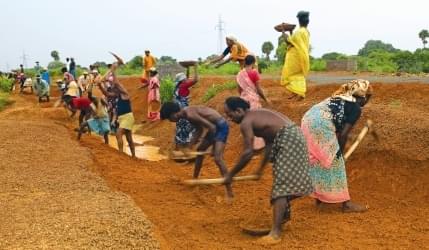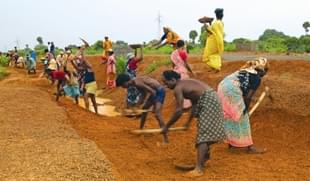Economy
NREGA: Let’s Not Throw the Baby Out With the Bathwater
Aditya K
Nov 17, 2014, 12:24 AM | Updated Feb 19, 2016, 06:06 PM IST
Save & read from anywhere!
Bookmark stories for easy access on any device or the Swarajya app.


This has nothing to do with Left or Right, only the evidence. Which shows that NREGA is making life better for the poorest of the poor.
As soon as the news of 28 eminent economists writing to Prime Minister Narendra Modi, expressing concern that his government would dilute NREGA (National Rural Employment Guarantee Act) broke out, the swords were out. Opinions were given on predictably partisan lines. NREGA critics primarily criticise it on its incentives and its macroeconomic impact given its cost. The proponents primarily advertise its success in improving standards of living, nutrition, education amongst the beneficiaries.
So what does the evidence say?
If I really need to give a bullet-point 140-character kind of a verdict on this one, it would be that NREGA is working. (And before people calling me a “deluded liberal”, I should say that I identify more with the Right than with the Left. I am simply talking hard evidence here.)
And the evidence shows that NREGA is making a difference to the lives of the poorest of the poor. Whether it is the best way to make a difference is obviously debatable. But the same can be asked about nearly everything.
First of all, through survey data, Jha et al (2012) estimate that NREGA income makes up for about 17% of total household income in Andhra Pradesh and about 10% in Rajasthan. That is a significant chunk. More importantly, about 50% of labour force participation through NREGA is by women.
How does it matter if a man or a woman gets the money, some will ask. Unfortunately or fortunately, it does.
There’s ample evidence for example, Chattopadhyay and Dufflo (2004) show that women have spending patterns that focus on different goods than men, which is relevant to policy making.
Kloner and Oldiges (2014) find that NREGA has been responsible for increasing household consumption by 30% in the slack season. And more importantly, it causes a poverty reduction of about 50% among Scheduled Castes (SCs) and Scheduled Tribes (STs). Some tend to dismiss the extent of acute poverty amongst SCs and STs. But for those who don’t, this is significant. And this is where NREGA outperforms the Public Distribution System (PDS) as it doesn’t have many targeting problems.
There has been some conflicting evidence on wage increase too. While Imbert and Papp (2012) report that wages in private sector employment have gone up by about 5%, Zimmerman (2014 ] finds no average impact on wages.
Another common criticism of NREGA is the lack of availability of labour in the private economy as NREGA sucks up the pool of unskilled labour. Since close to 70% of the NREGA work is taken up in the off-season, this is not as great a concern as some critics make it out to be.
There is some research on the quality of public works constructed through NREGA. In a recent survey across 20 districts in Maharashtra, Narayanan et al (2014) find that 87% of works recorded actually exist on the ground and 90% of respondents found them to be useful. A perception-based survey by National Sample Survey Organization (NSSO) found that 99% of rural households in Rajasthan, 82% of rural households in Madhya Pradesh and 64% of rural households in Andhra Pradesh were using the assets created by the program.
One major criticism of NREGA is corruption. From adding fake names to muster rolls to over-reporting for the number of days worked, all kinds of scams do take place. Niehaus and Sukhtankar (2012) find instances of corruption to the extent of 70-80% of the reported expenditure. But the most recent evidence by Dreze indicates that close to 70% of National Sample Survey data and NREGA data match, suggesting that at an aggregate level the incidence of corruption is not very high. Dreze himself admits that the survey data is not huge but it’s a reasonable starting point.
Moving on to the larger point of such policies versus cash transfers, a rights-based policy like NREGA rules out the possibility of excluding the poor. Whenever you design any welfare programme, two things can happen which might make it fail. Either most people who shouldn’t qualify for it get it and hence the expenditure turns out to be too high or most people who do need it don’t get it.
On either ground, an approach like NREGA has a better chance to work than cash transfer. Targeting is a major hurdle in cash transfers. This point cannot be glossed over. If one doesn’t demand any work to be done, then those who don’t need it will claim benefits. This is not to say that NREGA is better than cash transfer. But it is less likely to exclude those who need it or include those who don’t need it.
But where NREGA research is the most lacking and where most critics come from, is its macroeconomic impact and its harmful effect on incentives. NREGA has been argued to cause inflation and also, such populist policies are perceived to be responsible for creating a culture of getting doles for not working, as well as high fiscal deficit.
Neither charge can be refuted. The proponents always defend these charges by saying that there hasn’t been any satisfactory research establishing this causal link. While they are most certainly right in terms of evidence, I am not sure if that defence is the best one. This is because the standard of empirical rigour in academic research is high and therefore, no academic paper is likely to establish this causality beyond doubt.
Restricting NREGA to 200 districts is probably going to be a good move, if implemented by the government, as reports suggest it would like to do. I spoke to a few economists who were not signatories to the open letter but have worked a lot on NREGA. They say that despite being a rights-based policy, in reality it has become largely a supply-driven policy, so targeting it to the poorest districts would be a good idea.
So how about the proposal to replace NREGA with cash transfer as favoured by some economists?
When it comes to cash transfers, while theoretically it makes a lot of sense, there are a number of problems for which it is probably not as good a solution. First and foremost, as I have already mentioned, is the targeting issue. NREGA pays minimum wage and one needs to show up for work. A person with a better outside option isn’t going to demand work under NREGA. The corruption issue weakens this point but up to what extent is an empirical question.
To be more concrete, if we are comparing a corrupt NREGA to a perfect cash transfer, then that’s not a legitimate comparison. The real comparison would be between an imperfect NREGA and an imperfect cash transfer system and it’s not obvious which would be better.
Secondly, why would people move out of cash transfers? With NREGA, those who develop skills over a period of time and have better outside options will move to the private sector, which is the goal. The problem is, after giving cash, discontinuing it is going to be politically hard.
Lastly, let’s consider the public good provision aspect. Shoddy or otherwise, NREGA does carry an aspect of public goods provision. If we give cash, do we expect people to contribute from that cash to provide for public goods?
A lot has gone wrong over the last 10 years. But some things have gone right in that period too. Sure, NREGA has its faults, but it should be improved, not discarded. Let’s not throw the baby out with the bathwater.
(All opinions are my own. I would also like to thank my friend and colleague Siddharth Hari for his in-depth knowledge of NREGA research that helped me cite all the papers I do as well as for the hours I spent in discussing NREGA with him.)
A miserable engineer turned into a PhD student in economics. He enjoys decision theory, matching, game theory. Other interests include maths and cricket.





